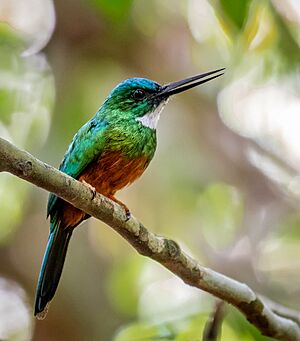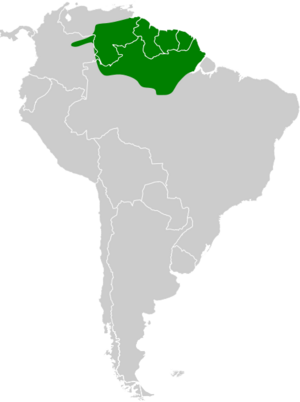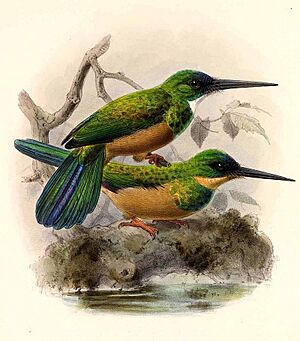Green-tailed jacamar facts for kids
Quick facts for kids Green-tailed jacamar |
|
|---|---|
 |
|
| A male green-tailed jacamar at Anavilhanas National Park, Novo Airão, Amazonas, Brazil | |
| Conservation status | |
| Scientific classification | |
| Genus: |
Galbula
|
| Species: |
galbula
|
 |
|
| Synonyms | |
|
Alcedo galbula Linnaeus, 1766 |
|
The green-tailed jacamar (Galbula galbula) is a beautiful bird with shiny, colorful feathers. It belongs to the Galbulidae family. You can find this amazing bird in parts of South America. It lives in countries like Brazil, Colombia, French Guiana, Guyana, Suriname, and Venezuela.
Contents
About the Green-tailed Jacamar
This bird is part of a group of similar birds called jacamars. It is closely related to birds like the rufous-tailed and white-chinned jacamars.
What Does It Look Like?
The green-tailed jacamar is about 18 to 22 cm (7.1 to 8.7 in) long. That's about the length of a ruler! It weighs around 18 to 29 g (0.63 to 1.02 oz).
Male birds have a shiny, coppery-green head and upper body. They also have a green band across their chest. Their tail is a pretty bluish-green color. Males have a white throat and a reddish-brown belly. Females look similar but have a buff (light yellowish-brown) throat. Their underparts are also a bit duller in color.
Where Does It Live?
You can find the green-tailed jacamar in eastern Colombia and southern Venezuela. It also lives in the Guianas and parts of northern Brazil.
These birds like to live on the edges of humid forests. They don't usually go deep into the forest. They prefer open woodlands, grassy areas called savannas, and bushy lands. They especially like areas near rivers and streams. You can find them from sea level up to about 700 m (2,300 ft) high.
Behavior and Habits
What Do They Eat?
The green-tailed jacamar mainly eats insects. They especially like to eat Hymenoptera, which include bees and wasps.
These birds often sit on exposed branches, sometimes in pairs. When they see a flying insect, they quickly fly out to catch it. Then they return to their perch to eat their meal.
Reproduction and Life Cycle
Green-tailed jacamars make their nests by digging burrows. They dig these burrows in earth banks. Sometimes, they even use nests made by termites in trees.
They have been seen breeding at different times of the year. For example, they breed from February to March in Venezuela. In Suriname, they breed in May, June, and August. In Brazil, they breed in April and September.
What Do They Sound Like?
The green-tailed jacamar has a unique song. It starts slowly and then gets faster and faster. It sounds like "peeo peeo peea pee-pee-pee-pee-pe-pe-pe-e-e-e-e’e’e’e". It often ends with a trilling sound.
Their call is a repeated "peep" or "peer" sound. Sometimes they make a series of these calls. You can listen to their sounds online.
Conservation Status
The IUCN (International Union for Conservation of Nature) has looked at the green-tailed jacamar. They have decided that it is a species of "Least Concern". This means that it is not currently in danger of disappearing. It is quite common in most of the places where it lives. It can also be found in several protected areas.



